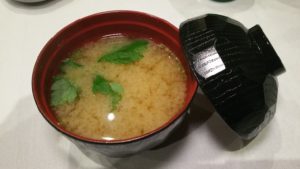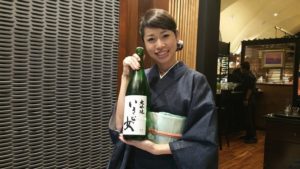
26 Sep Shiki Beverly Hills Serving Traditional Japanese Food (Washoku)
Amidst the steakhouses and Italian restaurants that line Canon Drive in Beverly Hills is the Japanese restaurant Shiki. Actually it is in the former location of Enoteca Drago, across the street from Wally’s and Wolfgang’s Steakhouse. Shiki is owned by Zen Noh, Japan’s National Federation of Agricultural Cooperative Associations, the largest agricultural cooperative in Japan. Zen Noh was started in 1972 to support small farmers. They opened Shiki in Beverly Hills in order to showcase and increase awareness of local specialty products, such as Wagyu beef and Japanese rice, amoung other products.
Chef Shigenori (Shige) Fujimoto is from the Gifu Prefecture in Japan. He trained in tradiitonal washoku as well as sushi and worked in Japan before coming to Los Angeles in the early 1990s. He worked at Matsuhisa Restaurant in Beverly Hills from 1993 to 2004 and then at the former Shige in Santa Monica, Irori in Marina del Rey and Asanebo in Studio City, which received a Michelin Star. In 2013, Fujimoto began working at Shiki.
Shiki features traditional Japanese food known as washoku (“wa” means Japan and “shoku” means cuisine). Focusing on local, seasonal ingredients, washoku has been registered as a UNESCO Intangible Cultural Heritage of Humanity. I was invited to the restaurant to try the washoku featuring local Japanese ingredients, from fish to vegetables to rice to the all important Wagyu Beef. Zen Noh exports Wagyu beef from eleven different factories who are certified to export to the United States. Based on ratings for yield (A-C) and quality (1-5), the Wagyu at Shiki is Premium Quality A5+.
Kumamoto Kaki: We started with three Kumamoto oysters from Seattle. These were the tiniest little oysters that I have ever seen and they were topped with Santa Barbara sea urchin, osetra caviar and a tomato and orange ponzu salsa. With the sea urchin, the salty ocean flavors were dominant. With the osetra caviar, the oyster was creamy and with the ponzu salsa, the oyster was bright and tart.
Nibitashi: Two thin pieces of sea bream were seared on cedar brick and served with deep fried skinless eggplant, spinach, shimeji and nameko mushroom from Japan and dashi broth. The was one of my favorite dishes of the night. The flavors were so delicate and a perfect balance between simple and complicated.
Premium Quality A5+ Wagyu Beef Wrapped Sea Urchin with Truffle: The Santa Barbara sea urchin is wrapped in a tender layer of seared A5 Wagyu beef from Kagoshima on Kushu Island and topped with summer truffle, a peeled tomato marinated in sweet dashi vinegar and sweet ponzu sauce. I really liked all of the elements of this dish and the delicate Wagyu beef just melted in the mouth. But the sea urchin was fairly dominate in the dish.
Kanpachi Sashimi with Sesame Miso & Serrano Pepper: The mild amberjack flavors were enhanced by the nutty miso and slight heat from the serranos. The yuzu juice and Hawaiin pink salt added a touch of brightness.
A5+ Wagyu Beef Soukiyaki: Long thin slices of Wagyu beef from the Kagoshima Prefecture are served with with tomato and red onion in a sweet soukiyaki sauce which is a mixture of soy sauce, sugar, and mirin. The sauce was so good I wanted to pour what was left on top of a bowl of rice.
Miso Soup
Nigiri Sushi: To finish the meal, we enjoyed a selection of fresh sushi including sea bream with yuzu pepper, tuna, seared fatty tuna, salmon, amberjack and gyoku (sweet egg).
Assistant Manager Mio Okura paired our meal with a selection of Japanese sakes ranging including Dewazakura “Ouka” Ginjo from Yamagata, Ikini Onno Daiginjo from Ishikawa, Tsukinokatsura Yanagi Junmai Ginjo from Kyoto and Hannya Umeshu Plum Sake.
The flavors at Shiki are delicate but sophisticated, blending sweet, sour, bitter and salt. The presentation of each dish is beautiful. You can order a la carte or select the omakase. Sushi omakase will cost $60 but the full omakase will be $130, $160 or $190. The number of courses will vary for each price point but the quality of ingredients will also increase. For $190 there will be ingredients such as caviar, truffle and live crab.
Whether you want to stop in for a few bites or sit down for the full omakase, you will find the ingredients at Shiki to be of the highest quality, showing you the best of what Japan has to offer.
Shiki Beverly Hills
410 N Canon Dr, Beverly Hills, CA 90210
310.888.0036
Discover more from Please The Palate
Subscribe to get the latest posts sent to your email.
















